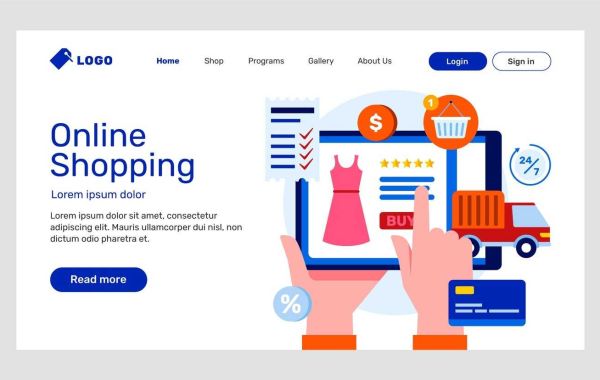In today’s digital age, having a well-designed eCommerce website is crucial for businesses looking to sell products online. A successful eCommerce site goes beyond just showcasing products; it provides an exceptional user experience that encourages visitors to make purchases and return in the future. The essential features that every eCommerce website should have to maximize functionality, enhance user experience, and drive sales.
User-Friendly Navigation:
Easy-to-Use Menu
A clear and intuitive navigation menu is fundamental for any eCommerce site. Your menu should be organized logically, with categories and subcategories that help users find products quickly. Consider incorporating a dropdown menu for subcategories and ensuring that your navigation is accessible from every page of the site.
Search Functionality
A robust search function is vital for an eCommerce site, especially if you have a large inventory. The search bar should be prominently placed and capable of handling various search queries, including partial words and synonyms. Advanced features like autocomplete and search filters can significantly enhance the user experience.
Mobile Responsiveness:
Mobile-Friendly Design
With a significant portion of online shopping happening on mobile devices, your E Commerce Website must be fully responsive. This means the site should adapt seamlessly to different screen sizes and orientations. Mobile-friendly design ensures that buttons are easily clickable, text is readable, and the overall user experience is smooth.
Fast Loading Times
Mobile users are often on the go and may have slower internet connections. A slow-loading site can lead to frustration and lost sales. Optimize images, streamline code, and leverage caching to ensure that your site loads quickly on mobile devices.
Secure Payment Options:
Multiple Payment Methods
Offering a variety of payment options can help cater to different customer preferences and increase the likelihood of completing a sale. Common payment methods include credit and debit cards, PayPal, digital wallets like Apple Pay and Google Pay, and even cryptocurrency. Ensure that the payment process is simple and secure.
SSL Certificates
Security is paramount in eCommerce. An SSL (Secure Sockets Layer) certificate encrypts data transferred between your website and your customers, protecting sensitive information such as payment details. Displaying a security badge can also help build trust with your customers.
High-Quality Product Pages:
Detailed Product Descriptions
Each product page should include comprehensive details about the item. This includes product specifications, dimensions, materials, and care instructions. High-quality descriptions help customers make informed decisions and reduce the likelihood of returns.
Professional Images and Videos
Visuals play a crucial role in online shopping. Invest in high-resolution images that showcase your products from multiple angles. Videos demonstrating the product in use can further enhance the shopping experience and provide additional context.
Customer Reviews and Ratings
Customer reviews and ratings provide social proof and can influence purchasing decisions. Implement a review system where buyers can leave feedback and rate products. Make sure to display reviews prominently on product pages.
Seamless Checkout Process:
Simplified Checkout
A complicated checkout process can lead to cart abandonment. Keep the checkout process as straightforward as possible, ideally requiring only a few steps to complete a purchase. Allow guests to check out without creating an account, but offer the option to register for faster future transactions.
Shipping Options
Provide multiple shipping options to cater to different needs and budgets. Clearly display shipping costs and estimated delivery times. Offering free shipping on orders over a certain amount can also be an effective incentive.
Easy Returns and Exchanges
A clear and simple return and exchange policy can build customer trust and reduce purchase hesitation. Ensure that your policy is easy to find and understand. Providing return labels or pickup options can also enhance the customer experience.
Effective Customer Support:
Live Chat and Support
Offering real-time customer support through live chat can significantly improve user satisfaction. Implement a live chat feature that connects customers with support agents who can assist with inquiries, track orders, and resolve issues promptly.
Comprehensive FAQ Section
An FAQ (Frequently Asked Questions) section can address common customer concerns and reduce the need for direct support. Include answers to questions about shipping, returns, payment methods, and product information.
SEO Optimization:
Keyword Optimization
To drive organic traffic to your eCommerce site, it’s essential to optimize your content for search engines. Research relevant keywords and incorporate them naturally into product descriptions, meta tags, and page titles.
High-Quality Content
Create valuable content that engages your audience and improves search engine rankings. This could include blog posts, buying guides, and product comparisons. Quality content helps establish your brand as an authority and can attract more visitors to your site.
Analytics and Tracking:
Integration with Analytics Tools
Utilize analytics tools like Google Analytics to track visitor behavior, sales data, and other important metrics. This information can help you understand how customers interact with your site, identify areas for improvement, and make data-driven decisions.
Conversion Tracking
Implement conversion tracking to monitor the effectiveness of your marketing campaigns. Track key metrics such as conversion rates, average order value, and cart abandonment rates to optimize your sales strategies.
Personalization Features:
Product Recommendations
Personalization can enhance the shopping experience and drive sales. Implement features such as product recommendations based on browsing history, purchase behavior, and customer preferences. Personalized suggestions can encourage customers to explore additional products and increase average order value.
Customized Offers and Discounts
Offering personalized discounts and promotions can help retain customers and boost sales. Use customer data to create targeted offers based on previous purchases or browsing behavior.
Social Media Integration:
Social Sharing Buttons
Integrate social media sharing buttons on your product pages and blog posts. This allows customers to easily share their favorite products with their networks, increasing your brand’s visibility and potentially driving more traffic to your site.
Social Media Feeds
Displaying social media feeds on your site can keep your content fresh and engage visitors. Consider showcasing recent posts, customer photos, or reviews from your social media channels.
Conclusion:
Building an effective E Commerce Website involves more than just setting up an online store. By incorporating essential features such as user-friendly navigation, mobile responsiveness, secure payment options, and high-quality product pages, you can create a site that not only meets but exceeds customer expectations. Investing in these features will not only enhance user experience but also drive sales and build long-term customer loyalty. As eCommerce continues to evolve, staying updated with the latest trends and technologies will help you maintain a competitive edge and achieve ongoing success in the digital marketplace.








